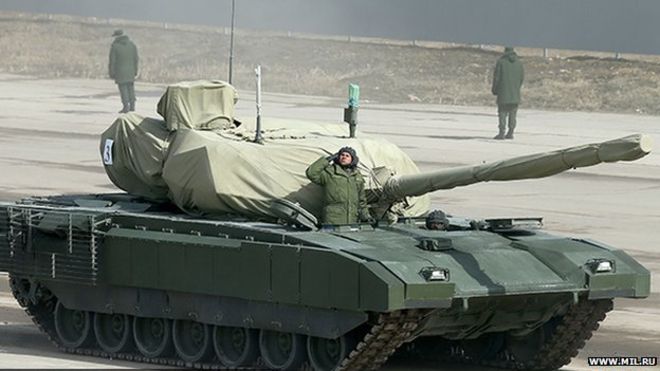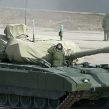
Moscow Displays New Military Hardware Amid Rising Tensions (Part One)
Publication: Eurasia Daily Monitor Volume: 12 Issue: 79
By:

Advanced preparations for the annual Victory Day (May 9) military parade in Red Square have revealed numerous examples of cutting-edge hardware entering service in the Russian Armed Forces. Controversy surrounds this year’s parade, which is set to mark the 70th anniversary of the end of the Great Patriotic War (Russian term for World War II), due to the decision by most Western leaders to avoid the event on account of Russia’s actions in Ukraine. However, amid continued sanctions passed by the United States and European Union, which are impacting the Russian economy, next month’s Victory Parade will be used to send a strong signal to the Euro-Atlantic alliance that Russia intends to continue modernizing its military as well as preparing and training its forces for future conflict (Lenta.ru, April 21).
On April 21, preparatory training exercises for the parade were staged in Alabino (Moscow Region). Earlier rehearsals focused on troop marches and aircraft flyovers. This latest exercise featured T-90 main battle tanks, BTR-80 armored personnel carriers (APC), GAZ-2975 Tigr armored vehicles, and Msta-S self-propelled howitzers. It also included various missile systems, ranging from the Iskander, Tor, Buk, and S-400 to the Topol-M intercontinental ballistic missile (ICBM). Reportedly, Moscow plans to showcase such systems, along with 16,000 troops and displays of air power over Red Square. Furthermore, the Russian military will highlight its most advanced weaponry and hardware: the experimental T-14 Armata battle tank, T-15 infantry combat vehicles, Kurganets-25 light tracked armored vehicles, Bumerang APCs and Koalitsiya-SV 152-milimeter self-propelled howitzers (RT, April 23).
Although advanced hardware was clearly earmarked to appear for the high-profile 70th anniversary Victory Day Parade, other less well publicized advances relate primarily to electronic warfare (EW) capabilities and also to the soldiers’ individual combat gear system “Ratnik.” Still, perhaps most excitement in the Russian media is due to the long-awaited public appearance of the T-14 Armata main battle tank. It is worthwhile to consider the features of this platform and how the introduction of this tank relates to Russia developing complementary hardware in the Armata series, particularly in the context of possible cuts to the defense budget affecting how many of these may eventually be procured.
The T-14 has been in the design phase for several years. The defense ministry finally received a batch of around 20 in February–March 2015 for testing, though larger numbers will not appear in the Ground Forces until 2017–2018. The tank itself is due to replace the older T-72s and T-90s and is based upon a platform offering a common chassis for 13 varied combat vehicles weighing up to 50 tons. It carries eight soldiers on-board, including its three-man crew, with increased firepower provided from an unmanned turret with a 125-mm cannon and an auto-loader using 32 rounds. It also has a manned 30-mm cannon and four Kornet-E guided missiles for increased protection. The T-14’s main armament is provided by the 2A82 125-mm smoothbore cannon. Its high-technology targeting system claims a 100-percent strike on target, and the self-protection system offers enhanced survivability against even Apache Attack helicopters (Defense Update, April 24).
The Armata series was designed and developed by the Uralvagonzavod Science and Production Corporation Open Joint-Stock Company for Specialized Technology. Its deputy director, Vyacheslav Khalitov, stated in January that some test tanks and vehicles would be sent to the defense ministry in February–March, but large-scale procurement is still two to three years away. He also explained that infantry fighting vehicles in the series were being designed on the basis of the T-14. Khalitov said the Russian Ground Forces could procure up to 2,300 units, but admitted the size of the order might be reduced due to economic reasons (Interfax, January 28; Ekho Moskvy, January 26).
The central compartment of the T-14 is well shielded, and the lower side hemispheres are protected by counter-missiles. Its engine and transmission compartment are located in the rear of the hull, running on domestically manufactured diesel with a reported power of no less than 1,500 horsepower. The T-14 combat information and control systems are built using digital technologies, constantly monitoring vitally important elements, and its heat sensing and thermal imaging allow it to operate 24/7 in all-weather conditions (Rossiyskaya Gazeta, February 3).
The T-14 marks a significant advance for the Russian military, long awaiting the appearance of a main battle tank more suited to its needs. It appears to have been designed for increased firepower, force protection, crew comfort and as a step toward integrating various Ground Forces platforms (Rossiyskaya Gazeta, February 3). If trials are successful, it is likely to yield—on the basis of the Armata chassis—recovery vehicles, a new general-purpose mine-laying system, transport and support vehicles, an armored bridge layer, an amphibious transport vehicle and a firefighting vehicle, among others. On the other hand, these models would not be fully integrated with hardware in the Airborne Forces.
Similarly, these trends are also in evidence in the new series infantry fighting vehicles, due to replace the existing BMP and BMD series. The Kurganets-25, also visible during the parade rehearsal in Alabino, is designed by Kurganmashzavod, the manufacturer of the BMP-2, BMP-3 and BMD vehicles. Unlike the older generation vehicles, the Kurganets-25 breaks from the traditional low profile design. Consequently, the vehicle is much higher, offering better protection against mines and improvised explosive devices (IED) (Defense Update, April 24).
These advances in Russian military hardware, with their triumphal display to coincide with the Victory Day Parade, are also consistent with the image of the Russian Armed Forces that emerged in the aftermath of the takeover of Crimea. Although those forces were largely elite and lightly armed, the image of “polite people” has taken hold. Thus, the defense ministry is keen to promote this better appearance of the Russian Army. Such hardware advances reveal some of the thinking behind such modernization, with the T-14 and Kurganets-25 being quite different from the platforms they will replace. But, equally, with these having been in the design stage for several years, they can only be intended for the types of conflicts Russian military thinking had formulated a few years ago. With much evidence emerging of Moscow using conflict in southeastern Ukraine to test new weapons and hardware, there could be further refinements in due course. Other areas of advance, less prominent in the Victory Parade, highlight a consistent theme of enhancing force survivability and on high-tech—not least in the personnel “Ratnik” system, but also in the growing effort to place EW at the heart of Russia’s military modernization.




